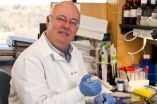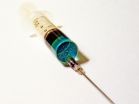(Press-News.org) A protein known as Sp2 is key to the proper creation of neurons from stem cells, according to researchers at North Carolina State University. Understanding how this protein works could enable scientists to "program" stem cells for regeneration, which has implications for neural therapies.
Troy Ghashghaei and Jon Horowitz, both faculty in NC State's Department of Molecular Biomedical Sciences and researchers in the Center for Comparative Medicine and Translational Research, wanted to know more about the function of Sp2, a cell cycle regulator that helps control how cells divide. Previous research from Horowitz had shown that too much Sp2 in skin-producing stem cells resulted in tumors in experimental mice. Excessive amounts of Sp2 prevented the stem cells from creating normal cell "offspring," or skin cells. Instead, the stem cells just kept producing more stem cells, which led to tumor formation.
"We believe that Sp2 must play a fundamental role in the lives of normal stem cells," Horowitz says. "Trouble ensues when the mechanisms that regulate its activity are overwhelmed due to its excess abundance."
Ghashghaei and his team – led by doctoral candidate Huixuan Liang – took the opposite approach. Using genetic tools, they got rid of Sp2 in certain neural stem cells in mice, specifically those that produce the major neurons of the brain's cerebral cortex. They found that a lack of Sp2 disrupted normal cell formation in these stem cells, and one important result was similar to Horowitz's: the abnormal stem cells were unable to produce normal cell "offspring," or neurons. Instead, the abnormal stem cells just created copies of themselves, which were also abnormal.
"It's interesting that both an overabundance of this protein and a total lack of it result in similar disruptions in how stem cells divide," Ghashghaei says. "So while this work confirms that Sp2 is absolutely necessary for stem cell function, a lot of questions still remain about what exactly it is regulating, and whether it is present in all stem cells or just a few. We also need to find out if Sp2 deletion or overabundance can produce brain tumors in our mice as in the skin.
"Finally, we are very interested in understanding how Sp2 regulates a very important decision a stem cell has to make: whether to produce more of itself or to produce offspring that can become neurons or skin cells," Ghashghaei adds. "We hope to address those questions in our future research, because these cellular mechanisms have implications for cancer research, neurodevelopmental diseases and regenerative medicine."
INFORMATION:
The results appear online in Development. NC State graduate students Guanxi Xiao, and Haifeng Yin, as well as Dr. Simon Hippenmeyer, a collaborator with the Ghashghaei lab from Austria's Institute of Science and Technology, contributed to the work. The work was funded by the National Institutes of Health and the American Federation for Aging Research.
-peake-
Note to editors: Abstract follows
"Neural development is dependent on the function of specificity protein 2 in cell cycle progression"
Authors: Huixuan Liang, Guanxi Xiao, Haifeng Yin, Jonathan M. Horowitz and H. Troy Ghashghaei, NC State University; Simon Hippenmeyer, Institute of Science and Technology, Klosterneuburg, Austria
Published: Development
Abstract:
Faithful progression through the cell cycle is crucial to the maintenance and developmental potential of stem cells. Here, we demonstrate that neural stem cells (NSCs) and intermediate neural progenitor cells (NPCs) employ a zinc-finger transcription factor specificity protein 2 (Sp2) as a cell cycle regulator in two temporally and spatially distinct progenitor domains. Differential conditional deletion of Sp2 in early embryonic cerebral cortical progenitors, and perinatal olfactory bulb progenitors disrupted transitions through G1, G2 and M phases, whereas DNA synthesis appeared intact. Cell-autonomous function of Sp2 was identified by deletion of Sp2 using mosaic analysis with double markers, which clearly established that conditional Sp2-null NSCs and NPCs are M phase arrested in vivo. Importantly, conditional deletion of Sp2 led to a decline in the generation of NPCs and neurons in the developing and postnatal brains. Our findings implicate Sp2-dependent mechanisms as novel regulators of cell cycle progression, the absence of which disrupts neurogenesis in the embryonic and postnatal brain.
Lack of protein Sp2 disrupts neuron creation in brain
2013-01-15
ELSE PRESS RELEASES FROM THIS DATE:
Never forget a Face(book) -- memory for online posts beats faces and books
2013-01-15
People's memory for Facebook posts is strikingly stronger than their memory for human faces or sentences from books, according to a new study.
The findings shed light on how our memories favour natural, spontaneous writing over polished, edited content, and could have wider implications for the worlds of education, communications and advertising.
The research, authored by academics at the University of Warwick (Dr Laura Mickes) and UC San Diego (including Professors Christine Harris and Nicholas Christenfeld), tested memory for text taken from anonymised Facebook updates, ...
Facebook beats books - and faces - in memory test
2013-01-15
If this were a Facebook post, you would remember it – better than a stranger's face or a line from a published book.
That, in fewer than 140 characters, is the finding of research from the University of California, San Diego and the University of Warwick, published in the Springer journal Memory & Cognition.
Oh, and: The small, social-networking faux pas you were hoping would fade from your friends' memories real soon…? Don't count on it. Sorry. :/
In "Major Memory for Microblogs," the researchers report that Facebook status updates were about one and a half times ...
War was central to Europe's first civilization, contrary to popular belief
2013-01-15
Research from the University of Sheffield has discovered that the ancient civilisation of Crete, known as Minoan, had strong martial traditions, contradicting the commonly held view of Minoans as a peace-loving people.
The research, carried out by Dr Barry Molloy of the University of Sheffield's Department of Archaeology, investigated the Bronze Age people of Crete, known by many as the Minoans, who created the very first complex urban civilisation in Europe.
"Their world was uncovered just over a century ago, and was deemed to be a largely peaceful society," explained ...
Federal Supplemental Nutrition Assistance Program use grows in 2011
2013-01-15
DURHAM, N.H. – In 2011, 13 percent of all American households relied on the Supplemental Nutrition Assistance Program (SNAP) -- the program formerly known as food stamps – with nearly 6.2 million more American households using the program now than five years ago, according to new research from the Carsey Institute at the University of New Hampshire.
"The Great Recession had profound effects on families across the United States, and economic recovery has been slow. Poverty and unemployment remained high in 2011, and job growth was stagnant. Amid these signs of a sluggish ...
Researchers identify genetic mutation for rare cancer
2013-01-15
By looking at the entire DNA from this one patient's tumor, researchers have found a genetic anomaly that provides an important clue to improving how this cancer is diagnosed and treated.
Researchers at the University of Michigan Comprehensive Cancer Center sequenced the tumor's genome through a new program called MI-ONCOSEQ, which is designed to identify genetic mutations in tumors that might be targeted with new therapies being tested in clinical trials.
The sequencing also allows researchers to find new mutations. In this case, an unusual occurrence of two genes ...
A quantum leap in gene therapy of Duchenne muscular dystrophy
2013-01-15
COLUMBIA, Mo.-- Usually, results from a new study help scientists inch their way toward an answer whether they are battling a health problem or are on the verge of a technological breakthrough. Once in a while, those results give them a giant leap forward. In a preliminary study in a canine model of Duchenne muscular dystrophy (DMD), University of Missouri scientists showed exactly such a leap using gene therapy to treat muscular dystrophy. The results of the study will be published in the journal Molecular Therapy on Jan. 15, 2013.
Muscular dystrophy occurs when damaged ...
New path discovered for future generation of glucose-measuring biosensors
2013-01-15
CIC bioGUNE researchers have opened a new pathway for the future development of biosensors that enable measuring the glucose in the blood, but which are also believed to be more reliable with other fluids, such as urine. To this end, a complex scientific process has been developed which has called into question a dominant paradigm amongst the scientific community with respect to the mechanisms of binding and communication between proteins.
The mechanisms of communication at subcellular level are based on the interaction between proteins or between proteins and metabolites ...
Plumber and spray painter high-risk occupations for asthma
2013-01-15
Despite known risks and recommendations for protective equipment, many people are still affected with asthma after exposure to chemicals at work. This is the finding of an international study of 13,000 people carried out at the Sahlgrenska Academy, University of Gothenburg, Sweden.
Asthma is among the most common adult diseases in the world. Despite the fact that the risks of chemical exposure have long been known and that there are well-established recommendations for handling chemicals and protective equipment, many cases of asthma are still caused by exposure to toxic ...
How the protein transport machinery in the chloroplasts of higher plants developed
2013-01-15
Halfway between bacteria and tree
How the protein transport machinery in the chloroplasts of higher plants developed
Moss Physcomitrella patens is an evolutionary intermediate stage
Together with colleagues from Sweden, RUB researchers have studied how the protein transport system of bacteria developed over time to form the system in the chloroplasts of higher plants. They explored the so-called signal recognition particles (SRP) and their receptors. Bioinformatic and biochemical analyses revealed that the moss Physcomitrella patens has evolutionarily old and new components ...
Designer bacteria may lead to better vaccines
2013-01-15
AUSTIN, Texas — Researchers at The University of Texas at Austin have developed a menu of 61 new strains of genetically engineered bacteria that may improve the efficacy of vaccines for diseases such as flu, pertussis, cholera and HPV.
The strains of E. coli, which were described in a paper published this month in the journal PNAS, are part of a new class of biological "adjuvants" that is poised to transform vaccine design. Adjuvants are substances added to vaccines to boost the human immune response.
"For 70 years the only adjuvants being used were aluminum salts," ...



